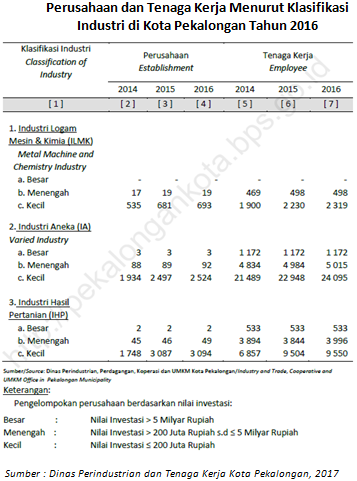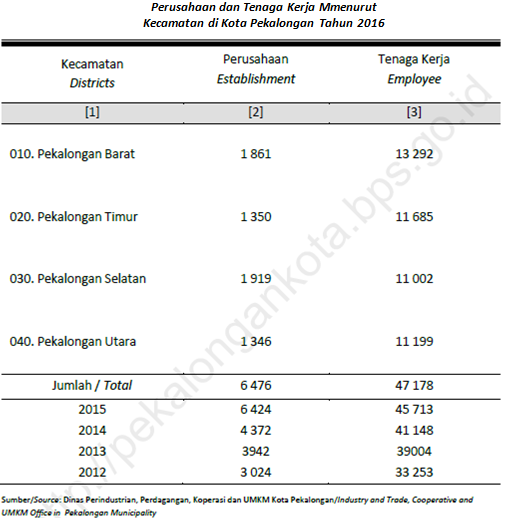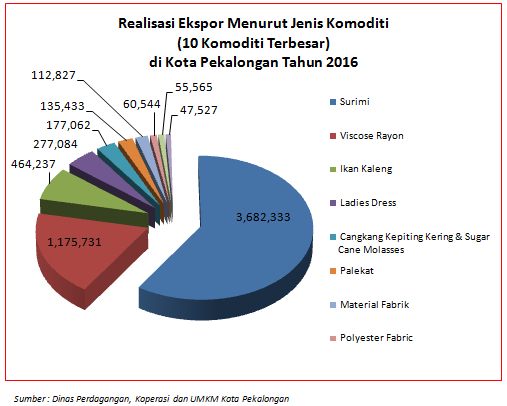Industry Sector
Manufacturing industries are grouped into 4 categories based on the number of workers, namely: big scale industry (100 employees or more), medium scale industry (20-99 workers), small scale industry (5-19 employees), and micro scale industry (1 -4 workers).
Based on the value of the investment, industry can be divided into a big industry that is> 5 billion rupiah, medium industries> 200 million rupiah ≤ 5 billion rupiah, and small industrial≤ 200 million rupiah. In this chapter the types of industry are grouped into three groups, namely MachineMetal Industry (ILM), Assorted Industry (IA) and Agricultural Products Industry (IHP). Industry in Pekalongan city are mostly small industries.
In 2016, the number of Small Industries as much as 6.311 companies (ILMK = 693, IA = 2.524, and IHP = 3.094). Big industry in Pekalongan city amounted to 5, consisting of Assorted Industry (IA) 3 companies and Agricultural Products Industry (IHP) 2 companies. While The Medium Industry in Pekalongan city amounted to 160 companies by type of Chemical Machine Metal Industry amounted to 19 companies, Assorted Industry totaling 92 companies, and 49 companies of Agricultural Industry.
Small and medium industries have increased in the number when compared to the previous year. While the Big Industryi number has not increased when compared to last year. Totally the number of industries in Pekalongan city rised 52 companies (0,81%) from 2015. The Data about the employment per industry types are also available.
1. Textile Industry and Textile Products (TPT)
Textile Industry And textile products (TPT) is one of the priority industrial sector becomes a mainstay of of the future. For that, in 2016, the growth rate of Textile Industry, Leather, Footwear and Multifarious Industriestargeted to rise 6.33% and gave a contribution of 2.43% of National Gross Domestic Product (GDP)."Industry Sector ofTPT will continue to be strong because it is labor-intensive and becomes the 'Social Safety Net' that supports people income. On the field of clothing industry is the largest contributor in the absorption of labor.
Currently the textile industry, ranking third of national export and provide employment to 2.79 million people with the products that are able to fulfil 70% of domestic clothing needs. Throughout 2015, the textile sector has contributed 1.22% to the national GDP and export surplus amounting to USD 4.31 billion. Value of textile exports reached USD 12.28 billion, contribute 8.17% from total value of national exports. The textile industry also contributes a large share in contributing foreign exchange. Total investment in that sector in 2016 reached IDR 7,54 trillions. Listed, textile sector contributed 5.05% for foreign investmen tand 3.07% for domestic investment.
Pekalongan city in 2016 noted that the exports realization of this commodity reached US$ 6.270.212, - or about IDR 83.694 Billions with the volume reaching 748.261 kg. The Textiles commodity components which is exported comprising: Sarung Batik, Sarung Palekat, Garment, Garment Batik, Ladies Dress, Material Fabric, Man’s Shirt, Veil, Ladies Blouse, Sajadah, Bed Cover, Bed Sheet, Polyester Fabric, Textile Fabric
Although the performance of the textile industry had declined 4.79% in 2015 due to the global economic crisis, the growth opportunities of this year is still very large. This is because Indonesia can appropriately responds to the global crisis and is already beginning to show an improvement in the national economy. Moreover, the middle class is becoming the locomotive of national consumption contributes quite a lot of economic growth. In other words, when the world market is weakening, the domestic market is still a great potential.
A number of challenges still to be faced by the textile business operators, such workers are not many certified in accordance their expertisethus inhibiting the ability of research and development in the industrial sector. Therefore, the Pekalongan city Government established a school State Community College (AKN) located at Jl. Perintis Kemerdekaan No. 30 as one of the efforts to fulfill the labor needs of the textile industry who are competent and competitive.
2. Tea Industry and Tea Drink
Employers of tea, batik, handicraft and fish, which has become a commodity in Pekalongan city expected to seize market opportunities in the domestic and international market penetration, and ready to face the Asean Economic Community (AEC). Among Tea Companies that have been operating in Pekalongan city, including :
1) PT. Sari Melati Sejahter (Teh Jawa)
2) PT. Laksana Sinar Bersama (Industri Teh)
3) PT. Baverly Hill (Teh Sepeda Balap)
4) Teh Dandang
5) Teh Bandulan
6) Teh Cangkir
7) Teh Enak
8) Teh 999
9) Teh Angon Bebek
10) Teh Nutu
11) Teh Arum Sari
Trading Sector
Trading sectors contributed the most to the economic structure in Pekalongan city that is equal to 22.33%, while the Industry sector is expected as a leading sector of supporting the economy by 21.74% and Contruction sector by 14,36% that is three major supporting economic structures in Pekalongan City.
The number of markets in Pekalongan city is 11 markets, located in the District of West Pekalongan City as much as 4 markets, East Pekalongan City 3 markets, South Pekalongan City 3 markets and the North Pekalongan City 1 market. In line with the increase of population, it's also increased the need for goods/services of the population, however, the number of merchants in 2015 in Pekalongan City reahed 4.516 merchants and in 2016 the number of merchants is 4.531. The Export realization value of Pekalongan City in 2016 amounted to US$ 19.081.546.65 increasing 9,79% over the previous year amount of US$ 17.384.060,75.
1. Batik
Batik Pekalongan is a kind of coastal batik with rich color. As typical of coastal batik, the motif is usually natural. When it is compared with other coastal Batik, batik Pekalongan is very influenced by immigrants of Chinese and Netherlands. Batik Pekalongan is very interesting, although It has the same motif with batik Solo or Yogya. It is often modified with attractive color variations. A piece of batik cloth can have up to eight colors with bold and dynamic combination. The most popular and famous motif of batik pekalongan is Jlamprang motif.
Batik Pekalongan widely is often marketed to the regions outside Java, including West Sumatra, South Sumatra, Jambi, Minahasa, to Makassar. Usually the batik traders in the area order batik with motifs that match the tastes and customs of each region. Even Batik Pekalongan has been already exported widely until many countries, such as America, Australia, Japan, Korea, Middle East, Africa and other countries.
The privileged Batik Pekalongan is that the batik makers always keep up to date. For example at the time of the Japanese invasion, it was born with the name Java Batik of batik "Hokokai", namely batik motifs and colors are similar to the Japanese kimono. In general, Hokokai Javanese batik is a kind of batik with motif ‘’pagi-sore’’.
In the sixties It was also created batik with Tritura name. Even in 2005, shortly after President Yudhoyono elected appears batik 'SBY' motif, which is similar to a cloth or songket weaving. The quite popular motif on these days is Tsunami. Indeed Pekalongan people never run out of ideas to make batik creations.
Examples of Batik Pekalongan Motifs and Patterns. Batik Pekalongan motif is almost similar to batik Yogyakarta, but Batik Pekalongan is more attractive and brighter. The characteristics of the original Batik Pekalongan motif are :
1) The characteristic ornament of Pekalongan
The original Pekalongan batik motifs shape plants and eagle ornament but no cecek sawut or cecek gori. The motif is cecek in the form of stripes or cecek pitu. Details cecek Pekalongan batik style is very prominent so that forming a line of motif ornament in the formed of cecek-cecek . One of the famous original subtlety Pekalongan batik brand for cecek motif is Oei Tjow Soen.
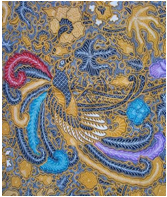
2) Batik Jlamprang Motif
Pekalongan batik motif Jlamprang is geometric shape. This motif influenced by religious symbols of Islam that avoids ornament in the form of living creatures. However, historians said that the Jlamprang motif was influenced Hindu Shiva culture.
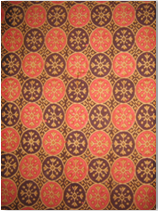
3) Batik Liong Motif
Batik Pekalongan motif seems like the Phoenix bird that is a bird with feather wings, head and tail are wavy and ornament Liong is a legged dragon as the influence of Chinese culture
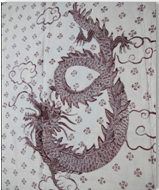
4) Batik Motif With Bright Color
The colors tend to be bright such as red, yellow, blue, violet and orange batik mainly produced in coastal areas of Pekalongan city.
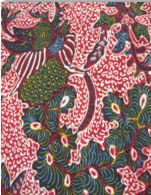
5) Batik Hokokai Motif
Batik was made at the time of Japanese invasion. The batik motif adopts a similar color and motif of kimono. In general, Hokokai Javanese batik is a batik motif ‘’pagi sore’’.

6) Batik Lawasan
Batik Lawasan is an old aged batik or old fashioned batik. Batik Lawasan comes from the Javanese word "Batik" and "Lawasan" from the word legacy (older). Batik lawasan also known by the name "Batik Lasem". Batik Lawasan or batik lasem refers to the age-old batik with classic motifs too. People sometimes misinterpret batik lawasan whereas an old batik.
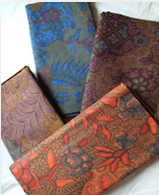
7) Batik Buketan
Batik Buketan motif is derived from the French word meaning bouquet of flower arrangements. This motif is easily recognizable because of a motif in this batik is floral, butterflies, birds  hong, heron, and plants that climb upward-spiraling like plants growing in Europe. The pictures are arranged in a series of beautiful, with beautiful colors.
The philosophy of this motif is happiness, joy, beauty, tenderness and purity. So, pembatik hope that the wearer always seemed cheerful and happy. This Buketan Batik motif made with bright colors and pretty, different with batik color of Yogya and Solo. You can see the color red, pink, blue, and color mix which is elegant and fresh.
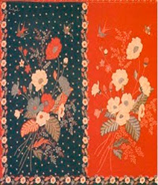
8) Batik Encim
One of the oldest batik motifs in Pekalongan is in the Kauman village. The motif of Batik Encim is a combination of Arab and Indian batik (Jlamprang) with Chinese batik influence.
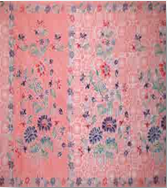
2. Merchandise Trade (Retail)
Pekalongan city has several shopping centers from the mall, grocery market to the traditional markets. Here is a modern shopping center in the Pekalongan City :
1) Plaza Pekalongan (Matahari Department Store & Hypermart)
2) Carrefour Mega Centre Pekalongan
3) Mall Pekalongan (Borobudur Department Store & Giant)
4) Pekalongan Square (Ramayana Dept. Store & Robinson)
Dan berikut adalah Pusat Perbelanjaan Tradisional yang ada di Kota Pekalongan :
1) Grocery Market of Batik Setono
2) Central market of Banjarsari
3) Central Market of Grogolan
4) Central market of Banyu Urip
5) Morning market of Keraton
6) Podosugih Market
7) Anyar Market
8) Kraton Market
9) Poncol Market
10)Klego Market
11)Central market of Kuripan

